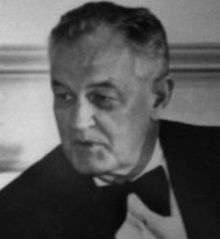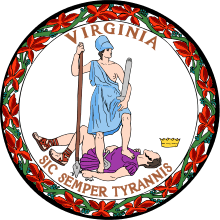Mills E. Godwin, Jr.
| Mills E. Godwin, Jr. | |
|---|---|
 | |
| 60th & 62nd Governor of Virginia | |
|
In office January 12, 1974 – January 14, 1978 | |
| Lieutenant | John N. Dalton |
| Preceded by | A. Linwood Holton, Jr. |
| Succeeded by | John N. Dalton |
|
In office January 15, 1966 – January 17, 1970 | |
| Lieutenant | Fred G. Pollard |
| Preceded by | Albertis S. Harrison, Jr. |
| Succeeded by | A. Linwood Holton, Jr. |
| 28th Lieutenant Governor of Virginia | |
|
In office January 13, 1962 – January 15, 1966 | |
| Governor | Albertis S. Harrison, Jr. |
| Preceded by | Allie E.S. Stephens |
| Succeeded by | Fred G. Pollard |
| Personal details | |
| Born |
Mills Edwin Godwin, Jr. November 19, 1914 Nansemond County, Virginia(now Suffolk, Virginia), U.S. |
| Died |
January 30, 1999 (aged 84) Newport News, Virginia |
| Resting place | Cedar Hill Cemetery, Suffolk, Virginia |
| Political party |
Democratic (until 1973) Republican (1973–1999) |
| Spouse(s) | Katherine Thomas Beale (m. 1940–99) |
| Children | Becky Godwin (d. 1968) |
| Residence | Chuckatuck, Virginia |
| Alma mater | College of William & Mary |
| Religion | Congregationalist |
Mills Edwin Godwin, Jr. (November 19, 1914 – January 30, 1999) of Chuckatuck, Virginia, was an American politician who was the 60th and 62nd Governor of Virginia for two non-consecutive terms, from 1966 to 1970 and from 1974 to 1978.
In his first term, he was a member of the Democratic Party, and was the last Virginia Governor elected as a part of the Byrd Organization, the conservative Democratic establishment that dominated the state's politics for over three decades. He was succeeded by the election of A. Linwood Holton, Jr., the first non-Democratic governor in over 80 years. By 1973, when he ran for a second term, Godwin had switched to the Republican Party, as the dominance of the Democrats in Virginia politics receded and the Byrd political machine had disintegrated. He was the first governor in the history of the United States to be elected as both a Republican and Democrat.
Youth, education, family
Godwin was born in Nansemond County (now Suffolk, Virginia) and educated at the Norfolk Division of The College of William and Mary, now Old Dominion University. He married Katherine Thomas Beale of Holland, also in Nansemond County. They adopted one child, Becky Godwin (b. 1954). In August 1968, while Governor Godwin was attending the Democratic National Convention in Chicago, Illinois, Becky and her mother were vacationing at the Oceanfront area of Virginia Beach when Becky was killed in a freak lightning accident.[1]
The family resided in the Chuckatuck section of Nansemond County, an area which became part of the consolidation of the former county with the former town and city of Suffolk centrally located which was the county seat. In 1974, the modern independent city of Suffolk was formed. It was the final of the city of Hampton Roads to take their current form during a wave of political consolidations in the Hampton Roads region which began in 1952.
His boyhood home, the Godwin-Knight House, was added to the National Register of Historic Places in 1985.[2]
Political career
Godwin served in the Virginia state senate between 1952 and 1962 and was the lieutenant governor between 1962 and 1966. In the state senate, Godwin was one of the leaders of the segregationist policy of "massive resistance," which aimed to prevent the implementation of federal court decisions under Brown vs. Board of Education requiring that black students be admitted to white schools. However, after 1960, he was among those leaders who became much more moderate as Virginia made the cultural transition, and distanced itself from the extreme positions of Senator Harry F. Byrd, Sr..
With an eye to the 1965 gubernatorial race, Godwin reached out to African American voters during the 1964 presidential campaign by campaigning for President Lyndon B. Johnson, who had led the movement for enactment of the Civil Rights Act of that year.
When he ran for governor in 1965, Godwin had no opposition from within the Democratic party and was therefore nominated without a primary election. His support of President Johnson the previous year, however, lost him the support of the most die-hard segregationists, who bolted from the Democratic party to support William J. Story, Jr., the candidate of the short-lived Virginia Conservative Party. Godwin's bid for governor in 1965 was endorsed by the local affiliates of both the NAACP and the AFL-CIO.
Despite the third party challenge, Godwin defeated the Republican Holton by a 48%-36% margin, with Story winning 13 percent of the vote. (American Nazi Party leader George Lincoln Rockwell, running as an independent, won 1.02 percent of the vote.)
After his first term ended in 1970, Godwin began to separate himself from the Democratic party. He managed the U.S. Senate campaign of Harry F. Byrd, Jr., who was running as an Independent candidate. Godwin was denied a seat at the Democratic state convention in 1972, and he was a member in the Texas organization of "Democrats for Nixon," supporting Republican Richard Nixon over the Democratic presidential nominee, George McGovern.
Although Lieutenant Gov. Henry E. Howell, Jr., had been elected to his office as an independent, against Democratic and Republican opposition, Howell appeared to be the front-runner for the Democratic nomination for governor in the 1973 election. Howell was a self-styled "populist," but many conservatives of both parties saw him simply as a liberal, whose push to the governor's office they believed had to be stopped. Former Governor Godwin was persuaded to run for governor by conservative Republicans who saw Godwin as the most likely candidate to beat Howell. Although Godwin sought and won the Republican party's nomination, he did not declare that he had personally switched his party affiliation until his speech to the Republican convention in which he accepted his nomination "as one of you." In the November 1973 election, Godwin defeated Howell to win his second term. Virginia law prohibits incumbent governors for running for consecutive reelection. Godwin became the only Virginia governor to be elected to two terms in the 20th century. Godwin narrowly defeated Howell by a margin of 15,000 votes, or a 50.7 to 49.3 margin. In another historic note, Godwin became the last Governor of Virginia to date whose party held the Presidency at the time of election, a distinction that had ended with the election of Democrat Terry McAuliffe in the 2013 gubernatorial elections.
As Governor, Godwin abandoned the state's "pay as you go" fiscal policy, which Virginia had followed since Harry F. Byrd's governorship, by having the state issue bonds to pay for capital projects.
On December 17, 1975 Governor Godwin ordered the James River and its tributaries closed to fishing from Richmond to the Chesapeake Bay. This order was the result of the improper handling and dumping of kepone into the James. Kepone is a chemical pesticide that was produced by Allied Signal Company in Hopewell, Virginia and caused a nationwide pollution controversy.
In 1976, Governor Godwin supported the bid of President Gerald R. Ford, Jr., for the Republican presidential nomination, against challenger Ronald Reagan. The Virginia Republican Party convention of that year, however, elected a largely pro-Reagan delegation to the 1976 Republican National Convention, although as a courtesy Godwin was designated as co-chairman of the delegation (but was required to share the co-chairmanship with Reagan supporter Richard D. Obenshain).
After the end of his second gubernatorial term, Godwin worked behind the scenes in the Virginia Republican Party until shortly before his death. Godwin died in 1999 of Pneumonia.
His personal papers, including papers from his time as governor, are held by the Special Collections Research Center at the College of William & Mary.[3] His executive papers from his time as governor are held by the Library of Virginia.
Memorials
Two schools in Virginia are named for him, including Mills E. Godwin High School in suburban Henrico, where the Becky Godwin Memorial Award is given annually to a senior selected by classmates,[4] and Godwin Middle School in Prince William County. Godwin Drive is located in the city of Manassas, Virginia. The Psychology/Biology building on the campus of Old Dominion University, formerly the Norfolk Division of The College of William & Mary, is named Mills Godwin Life Science Building. The former student center at Norfolk State University was also named in his honor. The building was demolished in early 2010 as a modern student center opened on campus. The Godwin Building on Northern Virginia Community College's Annandale Campus is also named for him. A Becky Godwin Memorial Scholarship is also given to college students at Godwin's former church, Oakland Christian Church, in Chuckatuck, Virginia. The church also dedicated a section of the church to Godwin known as the Godwin Building. Godwin Hall on the campus of James Madison University was completed in 1972 and was dedicated in honor of Mills E. Godwin and his wife Katherine, who was a graduate of the university.[5]
See also
- Becky Godwin, his daughter
References
- ↑ Speidell, Phyllis (2008-01-26). "'I'm so tickled I'm here' says 91-year-old former first lady of Virginia". The Virginian Pilot.
- ↑ Staff (2010-07-09). "National Register Information System". National Register of Historic Places. National Park Service.
- ↑ "Mills E. Godwin, Jr. Papers". Special Collections Research Center, Earl Gregg Swem Library, College of William and Mary. Retrieved 1 February 2011.
- ↑ http://scholar.lib.vt.edu/VA-news/VA-Pilot/issues/1995/vp950212/02100184.htm The Virginian-Pilot
- ↑ http://www.jmu.edu/map/buildings/GODW.shtml
External links
| Political offices | ||
|---|---|---|
| Preceded by Allie E. S. Stephens |
Lieutenant Governor of Virginia January 13, 1962 – January 15, 1966 |
Succeeded by Fred G. Pollard |
| Preceded by Albertis S. Harrison, Jr. |
Governor of Virginia January 15, 1966 – January 17, 1970 |
Succeeded by A. Linwood Holton, Jr. |
| Preceded by A. Linwood Holton Jr. |
Governor of Virginia January 12, 1974 – January 14, 1978 |
Succeeded by John N. Dalton |
| ||||||||
|
